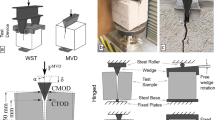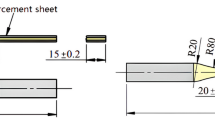Abstract
Changes in the elastic and viscoelastic (creep) characteristics of polymer concrete and its structural components (polyester resin, unfilled or filled with diabase flour) during a long-term exposure to water at 20°C were studied. Modeling the structural changes in polymer concrete with time showed an increase in the relative volume content of pores filled with water and a decrease in that of unfilled pores. Based on the free-volume concept and the data on swelling due to moistening and shrinkage due to physical aging of the binder, a rather accurate estimate of the time-moisture reduction function for polymer concrete was obtained. The function was found to be nonmonotonic: the interval of increase was followed by an interval of decrease.
Similar content being viewed by others
REFERENCES
Yu. S. Urzhumtsev and R. D. Maksimov, Prediction of Deformability of Polymer Materials [in Russian], Zinatne, Riga (1975).
O. A. Plushchik and A. N. Aniskevich, “Effects of temperature and moisture on the mechanical properties of polyester resin in tension,” Mech. Compos. Mater., 36, No. 3, 233–240 (2000).
O. A. Plushchik and A. N. Aniskevich, “Water sorption and swelling of polyester resin,” Mater. Tekhnol. Instrum., 6, No. 1, 49–53 (2001).
Yu. Khristova and K. Aniskevich, “Prediction of creep of polymer concrete,” Mech. Compos. Mater., 31, No. 3, 216–219 (1995).
K. Aniskevich and J. Hristova, “Prediction of creep of polymer concrete,” J. Appl. Polym. Sci., 71, 1949–1952 (1999).
P. Davies, F. Mazeas, and P. Casari, “Sea water aging of glass reinforced composites: shear behavior and damage modeling,” J. Compos. Mater., 35, 1343–1372 (2001).
E. P. Honig, P. E. Wierenga, and J. H. M. van der Linder, “Theory of elastic behaviour of composite materials,” J. Appl. Phys., 62, No. 5, 1610–1612 (1987).
K. Aniskevich, J. Khristova, and J. Jansons, “Creep of polymer concrete in the nonlinear region,” Mech. Compos. Mater., 36, No. 2, 85–96 (2000).
J. D. Ferry, Viscoelastic Properties of Polymers, John Wiley & Sons, New York (1970).
K. Aniskevich and J. Hristova, “Physical ageing of polymer concrete during creep,” J. Appl. Polym. Sci. (2002) (in print).
Author information
Authors and Affiliations
Rights and permissions
About this article
Cite this article
Aniskevich, K., Hristova, J. & Jansons, J. Deformational Properties of Polymer Concrete during Long-Term Exposure to Water. Mechanics of Composite Materials 39, 111–118 (2003). https://doi.org/10.1023/A:1023401226872
Issue Date:
DOI: https://doi.org/10.1023/A:1023401226872




